The more we use the Supermicro X11SCA-F, the more we like the platform. At its core, the Supermicro X11SCA-F is a crossover platform. It has the features one would want both for a workstation platform as well as a server platform which makes it intriguing. Supermicro is a leader in the workstation/ server crossover space and offers high-end dual socket crossover platforms as well. One can see an example in our Supermicro X11DAC Workstation and Server Motherboard Review or the previous generation Supermicro X10DAC Review. Based on LGA1151, the Supermicro X11SCA-F is a lower power and more affordable platform in this crossover segment.
Supermicro X11SCA-F Overview
At its essence, the Supermicro X11SCA-F is an ATX 12′ x 9.6″ motherboard that will fit in a wide variety of chassis. It is a single socket platform that is designed for consumer CPUs and lower-end servers. Although most of the server market is centered around dual-socket designs, the remote branch office server and some workstation platforms still use this class of system. Supermicro has created what may be the ultimate crossover motherboard in this category.
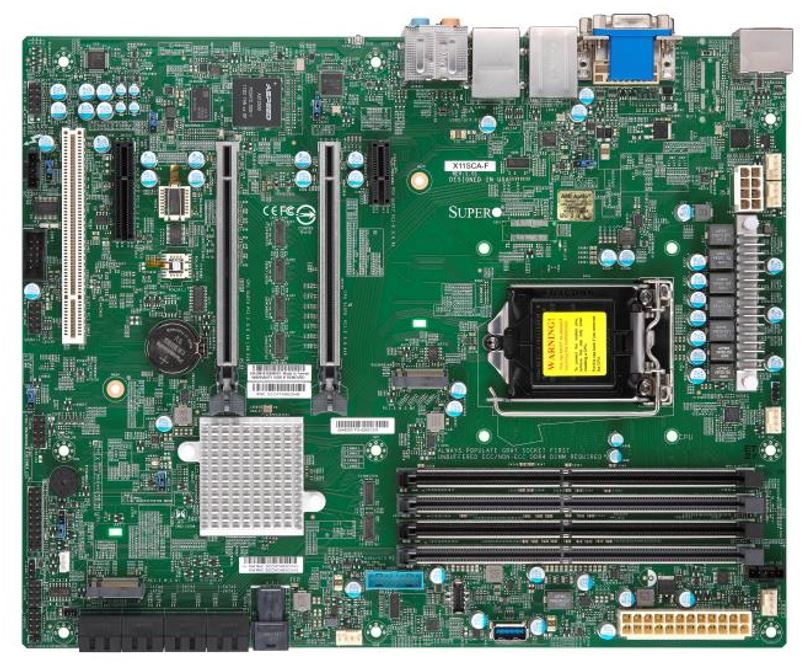
Here is the official diagram if you just want to see the overview. One can see the front edge of the motherboard has a USB 3.0 front panel header, a USB 3.1 Type-A header, and a USB 3.1 Type C header which is important for integrators who want to use this platform in a variety of scenarios.
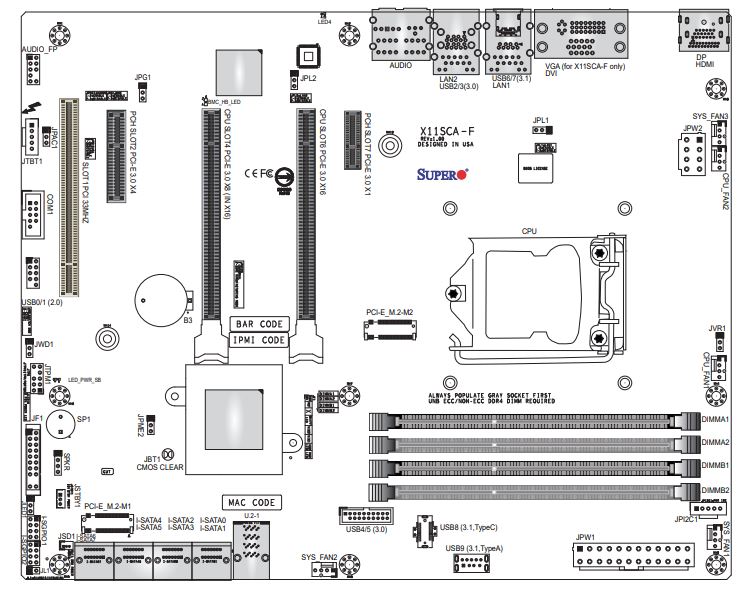
The CPU socket is Socket H4, an LGA1151 design. Here is where it gets really interesting, the platform supports a wide array of CPUs. It is a list that includes 8th gen Intel Core i9/i7/i5/i3/Pentium/Celeron Processors, Pentium, and the Intel Xeon E (Coffee Lake-S) server, Intel Xeon E-2100 (Coffee Lake-S) workstation processors.
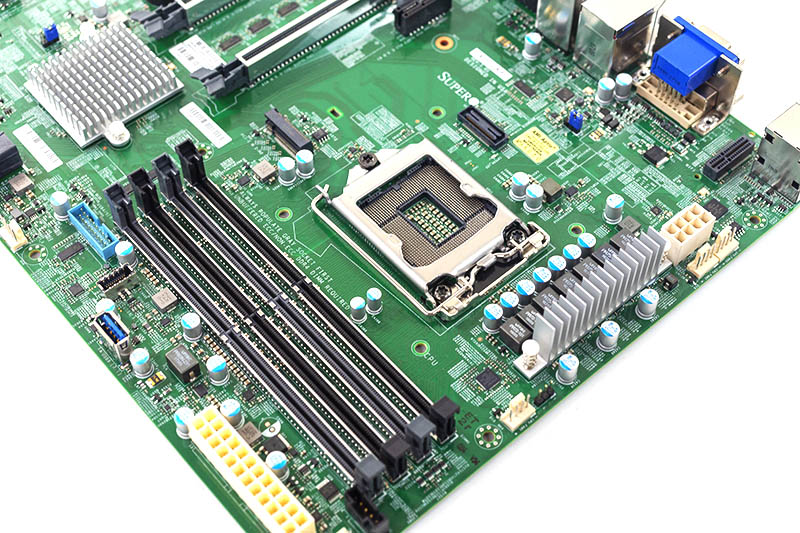
The DDR4 DIMM slots have metal on them and one side is fixed. This is to ensure that the slots stay stable and do not break in shipping or with DIMM upgrades. We have not seen a DIMM slot break on a motherboard in years, but only handle 100-150 platforms a year so it is not a sample size. This is a carry-over from the consumer side where motherboards have these extra features to entice enthusiast buyers.
We wanted to show off the storage connectivity for a moment. There are 8x SATA III 6.0gbps ports that are found in an array of 7-pin headers stacked parallel with the motherboard. These are controlled by the Intel C246 PCH. There is also an SFF-8643 header for U.2 NVMe SSDs. This is far more storage than many of the systems built on the Supermicro X11SCA-F will need, but it adds to the flexibility of the system.
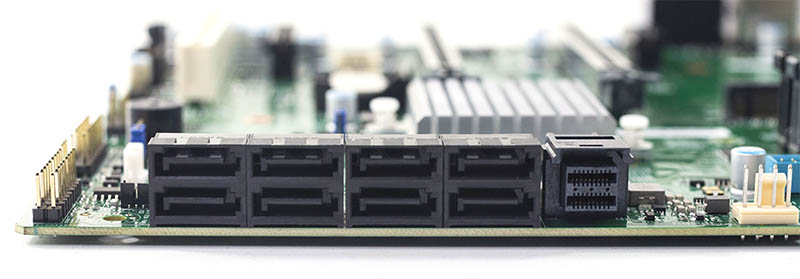
On the rear edge of the motherboard, you can see the ASPEED AST2500 BMC and its corresponding RAM. This is what gives the X11SCA-F its “-F” as it provides out-of-band management to the system. We will cover that OOB management later in this review, but it is a feature that allows this platform to be used either as a workstation or a server.
The expansion slot array is surprisingly large for this segment. There are two PCIe x16 slots. These can operate either in PCIe 3.0 x16/empty or x8/x8 mode. You can see these are shrouded in metal which is a workstation-style feature that is supposed to help with the rigidity of PCIe slots.
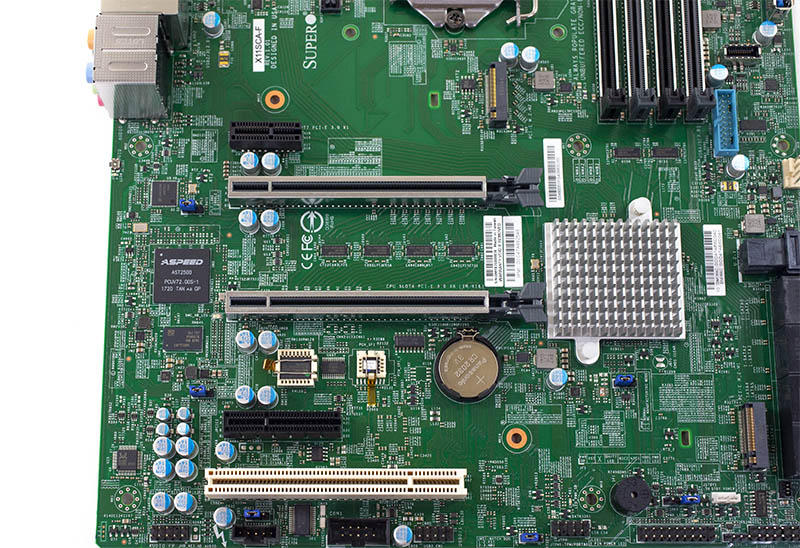
For additional peripherals, there are PCIe 3.0 x1 and PCIe 3.0 x4 slots. Neither interferes with a double-width cooler, for example with a GPU, in the x16 slots. Interestingly enough, one even has access to a 32-bit PCI slot. We are told that there are still customers who need to use legacy cards, so we have a 26-year-old slot on this new motherboard. PCI debuted in 1992 as your fun fact for the day.
Modern storage relies upon the M.2 form factor. Supermicro has a novel mounting system that allows consumer desktop standard M.2 2280 (80mm) NVMe SSDs in either M.2 header on the motherboard. Where this gets interesting is that the mounting system allows smaller drives, as well as the larger data center, focused M.2 22110 (110mm) NVMe SSDs that have power loss protection circuitry. Here is an example with a drive mounted in the top slot.
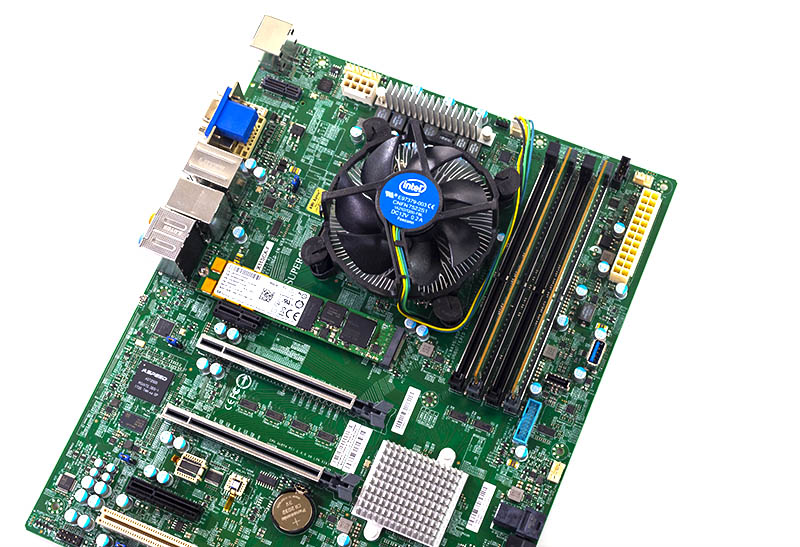
As you can see, the SK.Hynix NVMe SSD in the M.2 22110 form factor fits perfectly on this motherboard with Supermicro’s innovative mounting.
The rear I/O is nothing short of great. There is an array of display outputs. These include HDMI, Display Port, DVI, and legacy VGA. This array highlights the fact that there are too many display standards. It also allows for a wide variety of different devices to be connected. Deploying the Supermicro X11SCA-F as a workstation will likely mean using adapters for multi-monitor setups in conjunction with the Intel Xeon E-2100G series.
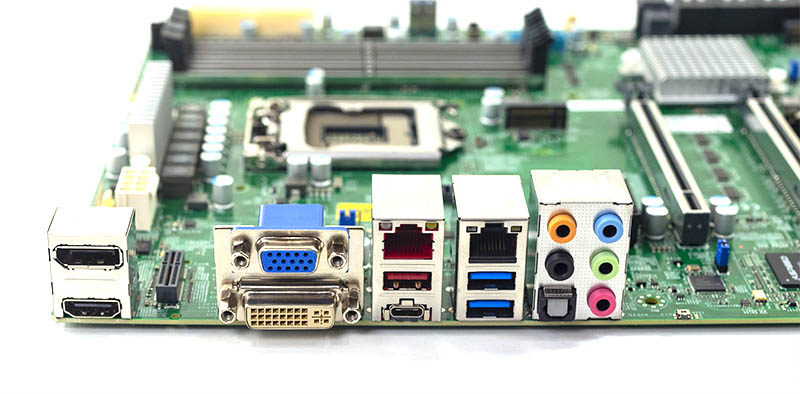
Audio is a fairly standard workstation array powered by ALC 888S HD audio. There are two network ports. One is controlled using the Intel i219LM chipset NIC. Powering the other is the Intel i210-AT an extremely popular server NIC. Along with standard networking duties, the i210-AT also provides OOB management network access for the ASPEED BMC.
Rear USB ports are 2x USB 3.1 Gen 1, 1x USB 3.1 Gen 2 Type-A, and 1x USB 3.1 Gen 2 Type-C. USB is an absolute mess in terms of naming at this point. Those four ports are not as many as we would find on a high-end consumer workstation motherboard, but they are also well beyond the typical server platform these days. That is even more so with the array of front panel headers available.
Now that we have taken a look at the motherboard, we wanted to pivot to show the block diagram so that you can see how the system is configurable. We will then go into the management features followed by our final thoughts.

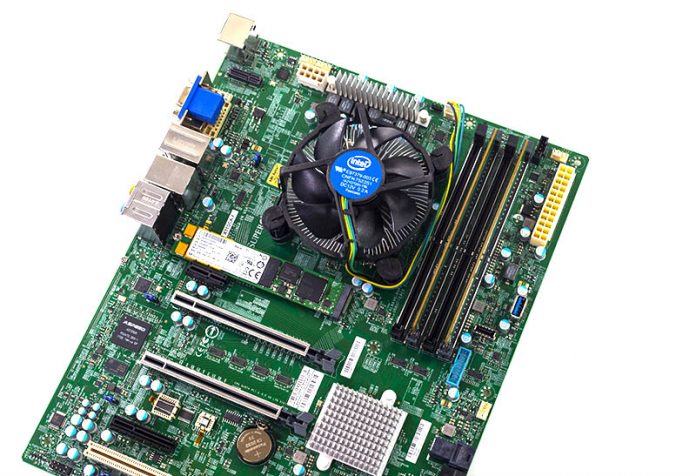



“The Intel Core i3-8300 is absolutely intriguing as one gets an iGPU plus four cores, without Hyper-Threading running at 3.7GHz for around $110. This is a major jump over previous 2 core/ 4 thread Core i3 designs. The Core i3-8300 also supports ECC memory. For those looking at a higher-performance option versus an Intel Xeon D, at a lower cost and without 10GbE onboard, the new Core i3 makes a lot of sense in low-end servers.”
You really get good deals on this processor, most people have to pay around $ 150.
Can you also include a Ryzen 3 2200G ($100) which also supports ECC in this test.
Misha that is fair. I got our review i3-8300 for $109 a few weeks ago, but I see prices around $145-$150. I will update that.
On the Ryzen side, not comparable. It does not have an IPMI enabled motherboard. There is an open FreeBSD hanging issue that is still a concern with Ryzen. We now have EPYC in the hosting cluster, but that was after a Ryzen test node got pulled.
There is another interesting feature in the bios that isn’t mentioned. The SG split graphics option allows 2 really neat setups that are not possible on any other board I have seen. The SG option lets you boot from the AST and still use the Integrated graphics as it activates the IGP display without loading the IGP vbios. Some unique scenarios:
1) Remote manage the bios and boot with the AST while using the IGP in windows.
2) Boot from the AST and pass the IGP to a VM (Normally the IGP has to be the primary graphics device for pass through to work)
Patrick, I’ve been considering a new NAS build and while I’ve worked with Supermicro in the past it’s been a while. I’m curious about your experience with the Aspeed BMC. Specifically I’m interested in using an iGPU processor but solely for offloading transcodes to QuickSync. Does use of the BMC require disabling the iGPU or can it just be prioritized in BIOS?
You can boot from the AST and use quick sync, you might need to use the SG option I mention above as I think QS often needs an active display.
To get around the active display requirement just use a standard display emulator dongle. Can be found from all usual suspects for a few dollars at most.
Slightly more expensive models usually allow you to select specific resolutions as well.
To bad you can’t do a test with Ryzen, FreeBSD 12 should solve the problems as far as I know. IPMI is band in many places because of security risks, so that won’t be an issue for us.
FreeBSD 11.2-STABLE – GCC 7.3 looks pretty stable on Zen
Very interesting how some of the 8th gen Core i3 line has ECC support. Thanks for that tip! I wonder why and whether ECC will eventually be available in the i5/i7/i9 lines.
Can someone clarify the external GPU thing with IPMI?
I currently have a Asus X299 PRO/SE workstation motherboard with IPMI and the ASPEED2500, with an Geforce 1070ti but i’m unable to use IPMI properly because it’s looking at the wrong gpu.
Will this motherboard support looking at the BIOS etc when using a discrete graphics card?
Aaron: you may be surprised but this is also known from previous lines of Intel chips where cheap i3 supports ECC (at least some, you need to verify in datasheets!) while i5/i7 not. So although you may view that as Intel tactics change, it’s not.
It is indeed very nice board, but in a light of this year reveals of Intel un-secure chip designs, the board more or less looks like a waste of designer/manufacturer time. Pity, it’s not done for Ryzen.
I agree with KareIG… What should have been an exciting board is overshadowed by the security failures of the chip its built around.
AMD needs to rub Supermicro nice and get them to produce some better boards for their chips. That way we can pretend we’re getting a safer chip until it’s flaws are found lol
Don’t be ridiculous. The security issues have been mitigated with a lot of effort in the industry to limit the impact. To add, it’s much less a concern for a clearly consumer/small biz platform.
“Much less a concern,” tell that to the 5 man law firm that has a small server in house for… Or a doctors office… Or any number of other small businesses that this board is targeted toward, be it workstation or server. No. Security is always of top concern when you make yourself liable for it.
@Mace: when the largest hacking firm in the world(NSA) considers it as a risk and therefore prohibit it (and the same counts for hyperthreading on intel CPU’s), it can be considered as a serious risk.
Is it possible to use a graphics card (PCIe 3.0 x16 slot), 10 Gb network card (PCIe 3.0 x4 slot) as well as a SSD on M.2 slot (PCIe 3.0 x4) without impact in performance regarding max. available lanes?
Patrick, Very nice, terse review. I noted “x8/x8” on the x16 PCIe slots.
Is there any chance Supermicro might enhance the BIOS for this motherboard
to support the x4/x4/x4/x4 add-in cards. There is an obvious engineering elegance
that obtains from 4 x NVMe SSDs @ x4 PCIe 3.0 lanes = x16 edge connector.
Does this mainboard support suspend to ram (standby)?
Previous generation (1151 v1) didn’t.
It would appear that the Intel i219LM is not supported in ESXI 6.7.
It shows up in ‘lscpi -v’, but not listed in the output from ‘esxcli network nic list’ nor the web interface (only the i210 shows up. Means (for now at least) the X11-SCA-F is essentially a 1 link GB board :-(
Mason, VMware ESXi drivers are very spartan. You simply need to install via an iso with the drivers added.
How about i3-8350K on this board? Board have TPD 95W in spec, cpu is 91W.
iwk: i am giving it a try with I3-8350K
I need to run Intel Graphics BUT the SX setting as Rob D mentioned did not work for me. Here is the best I could do. I have the X11SCA-F on a test bench simulating it is 20 miles away with keyboard and monitor and a cable to the HDMI port from the monitor. I leave the factory setting in bios of AUTO for graphics.
Now from my work computer I have perfect control through IKVM of the X11SCA-F and can run all programs and can fully access the bios just like with my REAL Super Micro servers. The X11SCA-F of course does NOT see the monitor hooked up to its HDMI port.
Now I use IKVM and go into bios and in graphics change the setting from auto to IGFX. I reboot. Now the user of the X11SCA-F simulated to be 20 miles away has perfect Intel 630 graphics thru the HDMI port. In fact I ran Passmark and the scores across the board including the CPU score ( I3-8100 gives 8540 versus standard of 8062 ) are better than a standard Z370 motherboard! But I have lost control of the Bios of the X11SCA-F! Sure I can reboot it and run it using IKVM or remote access but NOT bios. To access bios from my work station I have to request the simulated user 20 miles away to reboot and in bios change the IGFX setting in graphics back to AUTO. Cumbersome! ANY BODY GOT BETTER? Please advise me.
***** If not Serve the home should request a fix like a desk top app that will reboot the machine after having done the change in bios both ways! I have seen similar apps for other purposes on standard Asrock boards *** It should be a piece of cake and SM is a great company and has changed a bios for me on a similar issue on one of their VPro Boards! Thanks SM!
John Fickling
@Jim Nordbø: did it work with the i3-8350K?